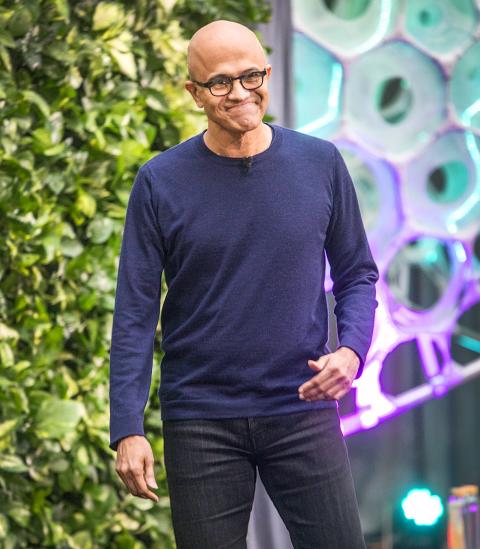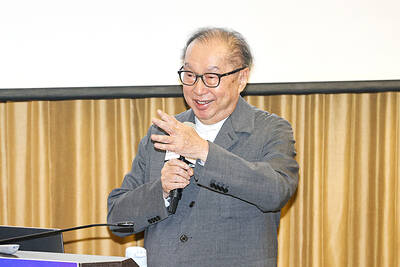Microsoft on Thursday said it would become “carbon negative” by 2030 as part of a ramped-up effort by the US tech giant to combat climate change.
The company said the initiative would by 2050 remove from the environment all the carbon emissions it has created since it was founded in 1975.
“The scientific consensus is clear — the world today is confronted with an urgent carbon crisis,” Microsoft chief executive Satya Nadella said while unveiling the initiative.

Photo: AP
“If we don’t curb emissions and temperatures continue to climb, science tells us the results will be devastating,” he said.
Microsoft, one of the world’s most valuable companies, said it has been carbon neutral since 2012 but that “neutral is not enough to address the world’s needs” to fight the effects of climate change.
Several tech companies, including Google and Apple, have committed to carbon neutrality and Amazon has said it would meet that goal by 2040. However, efforts to reduce the impact of carbon emissions have been rarer.
The British-based utility Drax last month said it would become the first company in the world to be carbon negative, removing more carbon dioxide from the atmosphere than it creates, by 2030.
Microsoft said it would invest US$1 billion during the coming four years through a new “climate innovation fund” dedicated to backing technology for carbon capture and removal.
“We deeply understand this is just a fraction of what is needed to solve this problem,” Microsoft chief financial officer Amy Hood said.
“We hope that by doing this we will set an example for both governments and other companies to invest along with us to solve this problem,” she said.
The fund would invest in technology already being developed and in promising new ideas for combating climate change, Hood said.
Those investments are expected to include putting money into “risky” developing markets and could include acquisitions by Microsoft, which also planned to work with its customers around the world on reducing carbon emissions.
The company would begin publishing annual reports on carbon emissions, and encouraged other companies to do the same. Internally, it has put a price on carbon emissions associated with products or services, and it urged others to do likewise.
Ideas put forward at the unveiling included adding carbon emission amounts to products in a manner akin to nutrition labeling on food so consumers can factor that into buying decisions.
“Shouldn’t people around the world be able to understand the carbon emission of a product when making purchasing decisions?” chief legal officer Brad Smith asked.
“Think of what that would do to incentivize businesses,” he added.
Microsoft would also use “its voice” to advance public policies and remove regulatory barriers when it comes to technology that fights climate change, Smith said.
The move comes amid growing concerns that climate change is accelerating, and data showing the past decade was the hottest on record.
“It’s a bold bet, to solve a big problem,” Smith said.
“The ultimate moonshot is to preserve this planet,” he said. “No individual, company or country can solve this by itself, but at Microsoft we will do our part and more.”

BYPASSING CHINA TARIFFS: In the first five months of this year, Foxconn sent US$4.4bn of iPhones to the US from India, compared with US$3.7bn in the whole of last year Nearly all the iPhones exported by Foxconn Technology Group (富士康科技集團) from India went to the US between March and last month, customs data showed, far above last year’s average of 50 percent and a clear sign of Apple Inc’s efforts to bypass high US tariffs imposed on China. The numbers, being reported by Reuters for the first time, show that Apple has realigned its India exports to almost exclusively serve the US market, when previously the devices were more widely distributed to nations including the Netherlands and the Czech Republic. During March to last month, Foxconn, known as Hon Hai Precision Industry

Taiwan Semiconductor Manufacturing Co (TSMC, 台積電) and the University of Tokyo (UTokyo) yesterday announced the launch of the TSMC-UTokyo Lab to promote advanced semiconductor research, education and talent development. The lab is TSMC’s first laboratory collaboration with a university outside Taiwan, the company said in a statement. The lab would leverage “the extensive knowledge, experience, and creativity” of both institutions, the company said. It is located in the Asano Section of UTokyo’s Hongo, Tokyo, campus and would be managed by UTokyo faculty, guided by directors from UTokyo and TSMC, the company said. TSMC began working with UTokyo in 2019, resulting in 21 research projects,

Ashton Hall’s morning routine involves dunking his head in iced Saratoga Spring Water. For the company that sells the bottled water — Hall’s brand of choice for drinking, brushing his teeth and submerging himself — that is fantastic news. “We’re so thankful to this incredible fitness influencer called Ashton Hall,” Saratoga owner Primo Brands Corp’s CEO Robbert Rietbroek said on an earnings call after Hall’s morning routine video went viral. “He really helped put our brand on the map.” Primo Brands, which was not affiliated with Hall when he made his video, is among the increasing number of companies benefiting from influencer

Quanta Computer Inc (廣達) chairman Barry Lam (林百里) yesterday expressed a downbeat view about the prospects of humanoid robots, given high manufacturing costs and a lack of target customers. Despite rising demand and high expectations for humanoid robots, high research-and-development costs and uncertain profitability remain major concerns, Lam told reporters following the company’s annual shareholders’ meeting in Taoyuan. “Since it seems a bit unworthy to use such high-cost robots to do household chores, I believe robots designed for specific purposes would be more valuable and present a better business opportunity,” Lam said Instead of investing in humanoid robots, Quanta has opted to invest